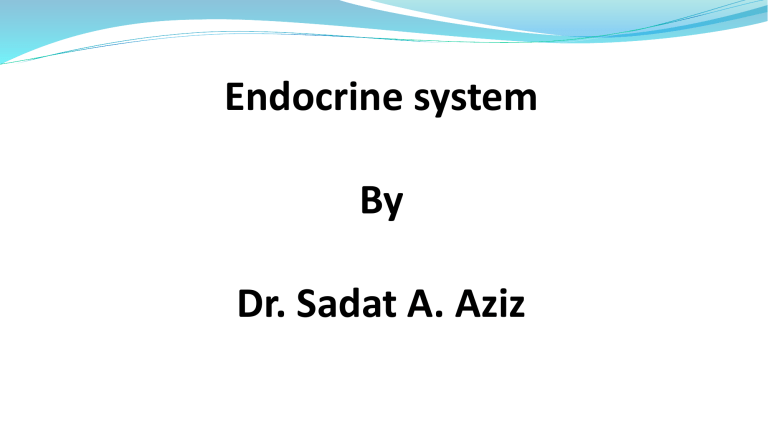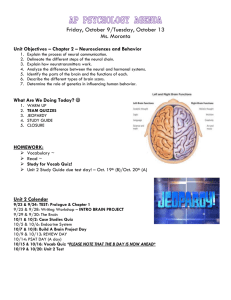
Endocrine system By Dr. Sadat A. Aziz The pituitary gland: It consists of two major portions, 1. The posterior pituitary gland 2. The anterior pituitary gland The hormones of the anterior pituitary gland: • They are in turn regulated by releasing hormones which are secreted from the hypothalamus and get to the anterior pituitary gland through blood. Growth hormone (GH) It is released by the anterior pituitary gland, it promotes growth through: a. Increases the rate of protein synthesis. b. Stimulates cell division and mitosis. c. It stimulates growth and wound healing. Disorders of the growth hormones: 1. Pituitary dwarfism: Hyposecretion of GH during childhood results in an abnormal growth rate (a final height of only 3 to 4 feet) with a symmetric and normal body proportions. This condition is treatable if it is diagnosed properly at the early stages of life. 2. Giantism (or gigantism): Hypersecretion of GH during childhood leads to this condition which is characterised by excessive growth of the long bones and the person may attain a height of 8 feet 3. Acromegaly: • it is a clinical condition resulted from hypersecretion of GH in an adult, • it is mainly caused by a pituitary gland lesion such as tumour. • This condition is characterised by disproportionately growth of the facial bones, the hands and feet. • Also the skin becomes thicker, and the tongue may protrude Prolactin: • It is secreted by anterior pituitary gland. • The secretion of prolactin can be regulated by breast-feeding. • Functions: • It initiates and maintains milk production by the mammary glands. • Other hormones of the anterior pituitary gland: • Follicle-Stimulating Hormone • Luteinizing Hormone The pancreas: It extends from the curve of the duodenum to the spleen. The pancreas is considered an exocrine and endocrine gland. The pancreatic endocrine function The hormone-producing cells of the pancreas are called islets of Langerhans Glucagon: • it is secreted by alpha cell of pancreas in response to hypoglycemia, a low blood glucose level. • It stimulates the process of gluconeogenesis, enhances liver to change glycogen to glucose and increases fats and excess amino acids turn over to energy. • So it raises the blood glucose level. Insulin: • it secreted by beta cells of pancreas in response to hypergycemia, high blood glucose level. • It increases the glucose up take by the cells. • In addition, it stimulates the liver and skeletal muscles to change glucose to glycogen (glycogenesis). • A deficiency of insulin hormone or its dysfunction is led to a condition called diabetes mellitus. Types of diabetes mellitus: 1. Diabetes mellitus type I: due to insulin hormone deficiency 2. Diabetes mellitus type II: resulted from defects in insulin receptors Somatostatin: It is released by delta cells and decreases secretion of both insulin and glucagon Adrenal glands: • The two adrenal glands are each located on top of a kidney. • Each adrenal gland consists of two parts: an inner adrenal medulla and an outer adrenal cortex. Adrenal medulla: The cells of the adrenal medulla secrete catecholamines (epinephrine and norepinephrine) in response to stress situation and prepare body for “fighting or flight”. Adrenal cortex: The adrenal cortex secretes three types of steroid hormones: mineralocorticoids (aldosterone), glucocorticoids (cortisol), and sex hormones (estrogens and androgens). Aldosterone: Aldosterone stimulate reabsorption of sodium and water, and the excretion of potassium by the kidney tubules. Cortisol: It is secreted in response to several physiological stress situations such as disease, physical injury, fear, anger, exercise, and hunger. Functions of cortisol: 1. Cortisol increases the use of fats and excess amino acids (gluconeogenesis) for energy and decreases the use of glucose. 2. Cortisol also has an anti-inflammatory effect. THYROID GLAND The thyroid gland is located on the front and sides of the trachea just below the larynx and is shaped somewhat like a butterfly. It produces thyroxine (T4) and triiodothyronine (T3). These hormones regulate the metabolic rate and the activity of the brain, muscles, heart, and virtually all other organs. Disorders associated with thyroid hormones: 1. Goiters: resulted from iodine defficiency, characterised by thyroid gland enlargement. 2. Cretinism: hyposecretion of thyroid hormone in new-born leads to development of this condition characterised by a sever physical and mental disabilities. 3. Grave`s disease: resulted from hypersecretion of thyroid hormone, characterised by an increase in the metabolic rate, weight loss, excessive sweating, fatigue and exophthalmos. Parathyroid gland: It secrets parathyroid hormone in response to hypocalcaemia. • Function: Parathyroid homeostasis hormone by regulates enhancing calcium intestinal reabsorption, reducing renal excretion, and increasing bone resorption of calcium. Para-follicular cells of the thyroid gland: • They are involved in the synthesis and secretion of calcitonin in response to hypercalcemia. • in general, has effects opposite to those of parathyroid hormone tends to decrease plasma calcium concentration by enhancing calcium deposition in the bone, increasing calcium secretion.






